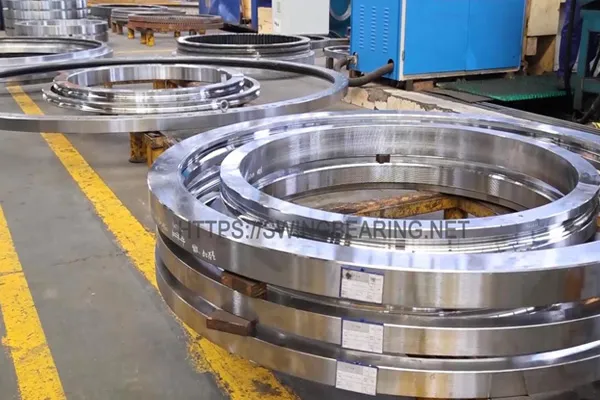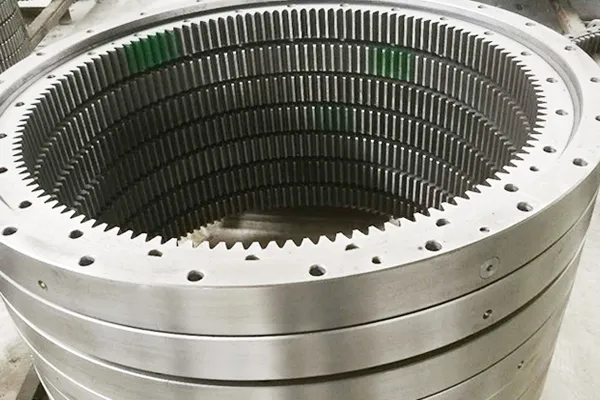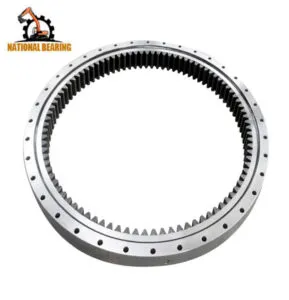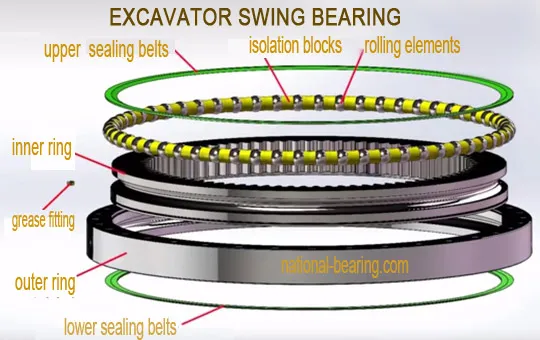
Ujawnianie ukrytej mocy: Lokalizowanie pierścienia obrotowego w koparce
Pierścień obrotowy (pierścień obrotowy), znany również jako łożysko obrotowe, jest krytycznym elementem koparki. Znajduje się u podstawy górnej konstrukcji koparki i umożliwia obracanie się górnej konstrukcji względem podwozia. Obrotnica jest odpowiedzialna za przenoszenie ciężaru górnej konstrukcji i sił kopania na podwozie. Umożliwia on również obracanie się koparki z boku na bok.

Pierścień obrotowy koparki
The pierścień obrotowy, a crucial component in an excavator, plays a pivotal role in enabling the machine’s upper structure to rotate smoothly upon its lower structure. Understanding its location is essential for maintenance and repair purposes.
Łożysko wahliwe znajduje się zazwyczaj u podstawy górnej konstrukcji koparki, gdzie łączy się z dolną konstrukcją. Składa się z dwóch koncentrycznych pierścieni, jednego przymocowanego do górnej konstrukcji, a drugiego do dolnej konstrukcji. Pierścienie są oddzielone szeregiem elementów tocznych, takich jak łożyska kulkowe lub rolki, które ułatwiają obrót.
Aby zlokalizować łożysko wahliwe, należy rozpocząć od zidentyfikowania górnej i dolnej konstrukcji koparki. Górna konstrukcja to część, w której znajduje się kabina, wysięgnik i ramię, podczas gdy dolna konstrukcja obejmuje gąsienice lub koła i podwozie.
Po zidentyfikowaniu górnej i dolnej struktury, poszukaj punktu, w którym się łączą. Zazwyczaj jest to okrągły lub sześciokątny otwór w środku górnej konstrukcji. W otworze tym znajduje się pierścień obrotowy.
W niektórych koparkach łożysko obrotowe może być częściowo lub całkowicie zamknięte w obudowie ochronnej. Obudowa ta służy do utrzymywania pierścienia obrotowego w czystości i smarowania, wydłużając jego żywotność. Aby uzyskać dostęp do pierścienia obrotowego, konieczne może być zdjęcie obudowy.
Lokalizacja pierścienia obrotowego może się nieznacznie różnić w zależności od konkretnego modelu koparki i producenta. Zazwyczaj jednak znajduje się on u podstawy górnej konstrukcji, gdzie zapewnia stabilne i niezawodne połączenie między górną i dolną konstrukcją.
Zrozumienie lokalizacji wieńca obrotowego ma kluczowe znaczenie dla zadań konserwacyjnych i naprawczych. Regularna kontrola i smarowanie wieńca obrotowego mają zasadnicze znaczenie dla zapewnienia jego prawidłowego funkcjonowania i zapobiegania przedwczesnemu zużyciu lub awarii. Wiedząc, gdzie znaleźć pierścień obrotowy, technicy mogą skutecznie wykonywać te zadania, maksymalizując wydajność i żywotność koparki.
Łożysko wahliwe, kluczowy element koparki, znajduje się u podstawy górnej konstrukcji, gdzie łączy się z dolną konstrukcją. To strategiczne umiejscowienie pozwala górnej konstrukcji obracać się płynnie i wydajnie, umożliwiając koparce wykonywanie szerokiego zakresu zadań.
Obrotnica składa się z dwóch głównych elementów: wewnętrznego i zewnętrznego koła zębatego. Wewnętrzne koło zębate jest przymocowane do górnej konstrukcji, podczas gdy zewnętrzne koło zębate jest przymocowane do dolnej konstrukcji. Gdy operator koparki aktywuje silnik obrotu, wewnętrzne koło zębate obraca się, napędzając zewnętrzne koło zębate i powodując obrót górnej konstrukcji.
The slew ring plays a vital role in the excavator’s functionality. It provides a stable and reliable connection between the upper and lower structures, ensuring smooth and precise rotation. Without a properly functioning slew ring, the excavator would be unable to perform its intended tasks effectively.
Umiejscowienie wieńca obrotowego u podstawy górnej konstrukcji jest nie tylko praktyczne, ale i korzystne. Takie umiejscowienie umożliwia łatwy dostęp podczas konserwacji i napraw, minimalizując przestoje i zapewniając ciągłość pracy koparki.
Oprócz swojej podstawowej funkcji, pierścień obrotowy przyczynia się również do ogólnej stabilności koparki. Zapewniając solidne połączenie między górną i dolną konstrukcją, pomaga równomiernie rozłożyć ciężar koparki, zapobiegając jej przewróceniu się podczas pracy.
Co więcej, umiejscowienie wieńca obrotowego u podstawy górnej konstrukcji pozwala na instalację dodatkowych komponentów, takich jak przewody hydrauliczne i elektryczne. Komponenty te są niezbędne do działania koparki i są wygodnie poprowadzone przez pierścień obrotowy, zapewniając ich ochronę i funkcjonalność.
Podsumowując, pierścień obrotowy jest krytycznym elementem koparki, znajdującym się u podstawy górnej konstrukcji. Jego strategiczne umiejscowienie umożliwia płynny obrót, zapewnia stabilność i ułatwia instalację niezbędnych komponentów. Zrozumienie funkcji i znaczenia wieńca obrotowego ma kluczowe znaczenie dla zapewnienia wydajnej i niezawodnej pracy koparki.
The slewing ring is a vital component in an excavator, playing a pivotal role in enabling the upper structure to rotate smoothly upon the undercarriage. Understanding its location, structure, and function is essential for troubleshooting common issues related to this critical part. This detailed guide will help you identify, diagnose, and resolve problems associated with the slewing ring, ensuring your excavator operates efficiently.
The slewing ring is typically situated at the base of the excavator’s upper structure, where it interfaces with the lower frame. It comprises two concentric rings: one fixed to the upper structure and the other to the lower frame. Between these rings are rolling elements, such as ball bearings or rollers, that facilitate the rotation of the upper structure.
To access the slewing ring, it is necessary to remove the upper structure from the undercarriage. This involves several steps:
Once the upper structure is detached, the slewing ring becomes visible as a large, circular component located at the base of the upper frame.
The primary function of the slewing ring is to facilitate the rotation of the excavator’s upper structure relative to its undercarriage. This allows the operator to maneuver the boom, arm, and bucket with precision, enhancing the excavator’s versatility and efficiency. The slewing ring must withstand significant loads and stresses during operation, making its proper maintenance and functioning critical.
One of the most common issues with the slewing ring is excessive wear. This can result from various factors, including heavy usage, inadequate lubrication, and contamination. Symptoms of excessive wear include:
To diagnose excessive wear, perform the following checks:
If excessive wear is confirmed, take the following steps:
Proper lubrication is crucial for the smooth operation and longevity of the slewing ring. Inadequate or incorrect lubrication can lead to increased friction, overheating, and premature failure.
Signs of lubrication problems include:
To resolve lubrication issues:

Łożysko obrotowe koparki
Bearing failure in the slewing ring can have severe consequences, including total operational shutdown. This issue can be caused by various factors, including overloading, poor maintenance, and manufacturing defects.
Symptoms of bearing failure include:
If bearing failure is suspected:
Regular monitoring and maintenance are crucial for preventing issues with the slewing ring and ensuring its optimal performance.
Perform scheduled inspections to identify potential issues before they become severe:
Ensure that operators and maintenance personnel are adequately trained:
The slewing ring is a critical component of an excavator, enabling the upper structure to rotate smoothly upon the undercarriage. Understanding its location, structure, and function is essential for troubleshooting common issues and ensuring optimal performance. By regularly inspecting, maintaining, and addressing issues such as excessive wear, lubrication problems, and bearing failure, you can prolong the life of the slewing ring and enhance the overall efficiency and reliability of your excavator.
By following these detailed maintenance practices, you can ensure that your excavator’s hydraulic system remains in top condition, providing reliable performance and longevity. Regular monitoring, proper lubrication, and timely replacement of worn components are key to preventing common issues and maintaining the efficiency of the slewing ring.

Struktura pierścienia obrotowego
1. Gdzie w koparce znajduje się pierścień obrotowy?
- Pierścień obrotowy znajduje się pomiędzy górną i dolną konstrukcją koparki.
2. Jaka jest funkcja pierścienia obrotowego w koparce?
- Pierścień obrotowy umożliwia obrót górnej części koparki względem dolnej części.
3. Jakie są rodzaje pierścieni obrotowych stosowanych w koparkach?
- Istnieją dwa główne typy pierścieni obrotowych stosowanych w koparkach: pierścienie obrotowe z łożyskami kulkowymi i pierścienie obrotowe z łożyskami wałeczkowymi.
Pierścień obrotowy, znany również jako łożysko obrotowe, jest kluczowym elementem znajdującym się u podstawy górnej konstrukcji koparki. Zapewnia wsparcie i umożliwia płynne obracanie się górnej konstrukcji na dolnej konstrukcji, umożliwiając koparce wykonywanie operacji kopania i wykopów z precyzją i wydajnością.